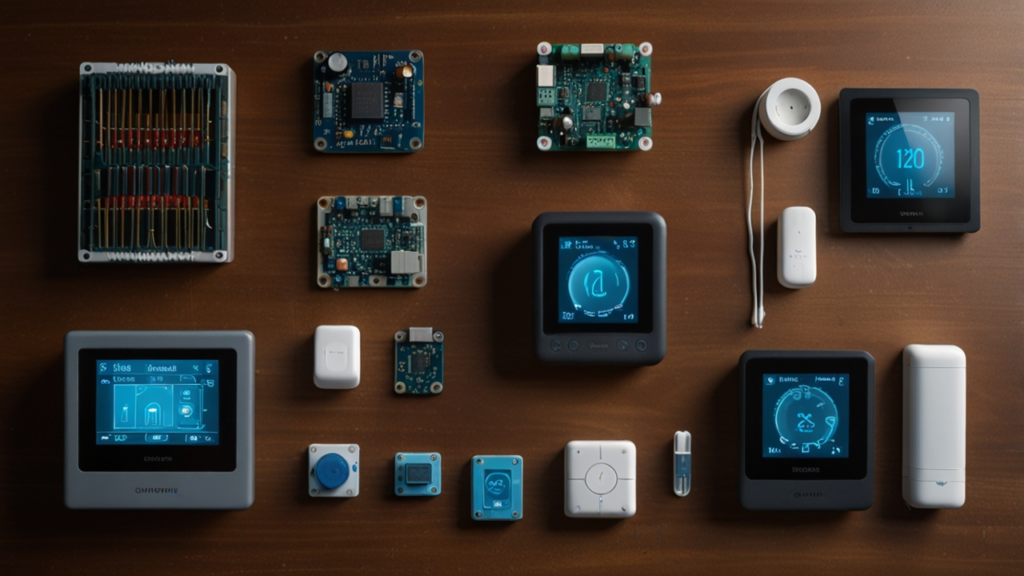Smart Grid: 8 Essential Capabilities
The modern electrical network has undergone radical transformation over the past century. With the emergence of electronic control and two-way digital communication, these grids have become more responsive and reliable. This evolution offers enhanced control and better management of our energy resources.
Innovations since the early days of electrical distribution have paved the way for systems that not only supply energy but optimize its usage. Early pioneers laid the foundation with limited data, while today’s developments incorporate real-time monitoring and automation. This progress has significantly reduced outages and improved efficiency worldwide.
Today’s grids are more than just networks of wires and poles. They integrate advanced technologies across multiple layers, ensuring efficient delivery of energy to diverse communities. This article explores the essential capabilities and future potential of these transformative systems.
Table of Contents
Introduction to Smart Grid
In today’s fast-paced world of technological advances, the evolution of electrical networks has reached new heights. Systems now integrate digital controls that foster ease of management and reliability. For additional insights on modern technology trends, explore Green Technology.
Definition and Importance
The concept of a modern network involves the convergence of traditional electrical distribution and cutting-edge digital communication. It is defined as a configuration that enables two-way data exchange between utilities and end users. This definition is backed by detailed discussions available on Wikipedia (detailed study).
This system is significant because it enhances operational efficiency and creates avenues for automated fault detection. As a result, outages are drastically reduced, and energy conservation is improved. The streamlined operation not only saves resources but also supports sustainable developments.
Have you experienced energy management improvements in your community? This innovative approach creates a transformative environment in which energy delivery is optimized and reliable.
Key Components Overview
The fundamental aspects include digital communication channels, two-way data exchange modules, and advanced metering infrastructure. These components work in unison to offer detailed insights into system usage. Supporting literature from Hitachi Energy reinforces these technical details.
The system architecture is layered, allowing for granular management and prompt corrective actions. This design ensures that energy distribution is both flexible and resilient in the face of unexpected load changes. Would you like to know how each component works together to reduce energy wastage?
For more information about the operational aspects, further research on established platforms is advisable.
Evolution and History of Smart Grid
Historical breakthroughs have set the stage for today’s digital energy systems. The journey began with early electrical grids characterized by unidirectional energy flow and sparse data. For further context, check out Energy Efficiency.
Historical Milestones
The journey started in the late 19th century with Thomas Edison’s Pearl Street Station in New York (1880). Innovations by Nikola Tesla and George Westinghouse laid the technical groundwork for modern distribution, as recounted in LandApp (U.S. grid history). These milestones demonstrate the evolution from manual meter readings to sophisticated digital interactions.
By the 1980s, systems began integrating automatic meter reading, which evolved into the Advanced Metering Infrastructure (AMI) of the 1990s. The deployment of Italy’s Telegestore Project from 2000 to 2005, where 27 million smart meters were installed, significantly reduced losses by 80%. Does this historical progression excite you about the future possibilities?
This progression shows how foundational engineering efforts enable modern innovations that enhance network reliability and security.
Progressive Technological Integration
Technological integration continued with the introduction of mesh networks in locations such as Austin, Texas (2003) and Boulder, Colorado (2008). Each innovation provided a deeper level of system management and improved outage response. External sources like Rugged Mobility (industry updates) provide additional insights into these developments.
Further, countries like Japan and China have pushed the boundaries with advanced systems such as the national Wide Area Measurement System (WAMS) implemented in 2012. Do you wonder how such integrations are redefining power distribution at the national level?
This continuous upgrade in hardware and software platforms reinforces the evolution from classical to dynamic, digitally enhanced operations.
How Intelligent Electricity Enhances Smart Grid
The incorporation of digital communication has revolutionized traditional systems. Real-time monitoring is crucial for precise energy management. For more related reading, visit IoT (Internet of Things).
Role of Digital Communication
Digital communication transforms energy distribution by enabling immediate data exchange between sensors, meters, and control centers. Communication protocols such as Zigbee, Wi-SUN, and LTE ensure seamless flow of information. Researchers have documented these advancements in technical literature, noting significant improvements in efficiency.
The integration of digital systems ensures that signals are transmitted with minimal delay, leading to proactive responses to faults. This capability allows utilities to take corrective actions even before significant issues occur. Can you imagine the benefits of instantaneous data in everyday energy management?
This robust communication framework is a critical component that supports the reliability and resilience demanded by modern networks.
Impact of Automated Systems
Automation plays a pivotal role in enhancing the performance of advanced networks. Systems such as Supervisory Control and Data Acquisition (SCADA) and automated switches react in real time to changes in load conditions. The benefits are clear: reduced outage durations and enhanced system responsiveness.
Automated systems underpin modern network management by enabling dynamic responses to potential issues, as evidenced in various pilot projects across the globe. This integration ensures that energy delivery is not disrupted, even during peak usage. Have you ever witnessed the power of automation in your local energy supply?
For more detailed exploration of these advancements, early studies in this sector hint at the long-term benefits for distribution resilience.
Adaptive Power Systems and Their Applications
Adaptation in energy networks involves the restructuring of power layouts to meet diverse demands. New technologies have made these systems resilient and flexible. Further exploration can be done by checking out Smart Home Technology.
Decentralization and Resilient Power
Decentralized layouts allow local nodes to operate independently during system failures. This concept ensures that even if one substation malfunctions, others continue to supply power. Regional success stories, such as those in parts of the United States, have shown remarkable improvement in outage management.
Smaller, localized grids formed from these principles can operate efficiently under stress. Decentralization promotes system stability and enhances overall security. Are you curious how this resilience can protect critical infrastructure during emergencies?
The strategic implementation of these systems paves the way for more resilient and adaptive energy management techniques.
Integration of Renewables and Storage
Adaptive systems now integrate renewable sources and storage solutions seamlessly into their networks. The use of solar panels, wind turbines, and battery facilities significantly contributes to energy sustainability. Supportive literature from ARUSI (engineering insights) provides in-depth technical details.
This integration not only improves resilience but also facilitates better load management during peak periods. The combination of distributed energy resources ensures that power is available when needed. Does the promise of a greener, more efficient future resonate with you?
Such integration underlines the capacity of modern systems to transform energy management across different regions.
Real-World Case Studies of Smart Grid
Case studies highlight practical applications of technological advancements in energy networks. The success stories from diverse regions demonstrate the impact of these systems on society. For further insights, visit Tech Developments.
Successful Global Implementations
Examples of successful implementations include Italy’s Telegestore Project, which deployed 27 million smart meters between 2000 and 2005. This project reduced non-technical losses by 80% and revolutionized remote management of electricity supply. Additional insights can be found in studies available on IEA (smart grid statistics).
The systems employed in Austin, Texas, demonstrated effective dynamic pricing and improved outage responses. Such implementations are widely recognized for setting new benchmarks in system performance and reliability. Have you observed similar initiatives making a difference in your locality?
The success of these projects has established benchmarks for future developments, inspiring further global adoption.
Regional Variations and Outcomes
Different regions have adapted their systems according to local challenges. In Asia, for instance, China has led with its national Wide Area Measurement System (WAMS) to stabilize extensive renewable integration. Japan’s initiative to adjust for dual-frequency grids further highlights regional customization.
Case studies reveal that localized pilot projects, such as those in South Korea on Jeju Island, have successfully merged renewable energy and advanced monitoring systems. These successes indicate a promising direction for diverse and region-specific applications. Can you imagine a similar transformation in your area?
Such regional outcomes offer valuable perspectives on overcoming unique technical challenges while maintaining overall system integrity.
Comprehensive Comparison of Case Studies
| Example | Innovation | Impact/Outcome | Region |
|---|---|---|---|
| Telegestore Project | 27M Smart Meters | 80% loss reduction | Italy |
| Austin Mesh Network | Dynamic Pricing | Improved outage response | USA |
| WAMS Rollout | Advanced Monitoring | Enhanced stability | China |
| Dual-Frequency Adaptation | Grid Modernization | Resilience building | Japan |
| Jeju Test-bed | EV & Renewables Integration | Innovative EMS | South Korea |
Do these examples inspire you to envision even more innovative solutions for energy systems? For more information on similar projects, reliable reports and studies are available online.
Energy Optimization in Modern Smart Grid Solutions
Optimizing energy use has become a cornerstone of modern electrical networks. With real-time metering and advanced analytics, systems achieve maximum efficiency. For additional context, consider the insights from IoT (Internet of Things).
Demand Response and Efficiency
Demand response initiatives empower networks to adjust energy usage based on fluctuating demand. These systems leverage automated price signals and instant feedback to reduce peak loads. Recent studies indicate that such adjustments significantly cut energy waste, as noted by various research institutions.
This proactive management enhances overall efficiency and stabilizes the load during high-demand periods. Customers benefit from real-time pricing models that encourage energy-saving behaviors. Have you ever adjusted your usage in response to a demand response event?
This approach not only elevates system reliability but also provides economic incentives for energy conservation.
Advanced Metering and Data Analytics
Advanced metering infrastructure (AMI) and deep data analytics are the backbone of modern network optimization. These tools collect crucial consumption data, enabling utilities to forecast demand and respond dynamically. The integration of such tools is well documented in technical sources and pilot projects.
Analytics convert raw data into actionable insights that drive proactive maintenance and reduce non-technical losses. By analyzing usage patterns, operators can pinpoint inefficiencies and implement corrective measures swiftly. Would you be interested in a system that anticipates your energy needs before you even notice them?
This data-driven approach is fundamental to achieving a balance between energy supply and demand, ultimately enhancing overall system performance.
Future Trends: Utility Revolution and Beyond
The next phase of advancements promises even more transformative changes in electrical networks. Emerging technologies and market dynamics will redefine the landscape. For more details on technological innovations, visit Tech Developments.
Predictions and Next-Gen Innovations
Experts predict that artificial intelligence and advanced analytics will soon drive most network operations. This evolution will bring fully automated, self-healing systems that reduce outages even further. Industry leaders suggest that by 2030, these changes will revolutionize how energy is monitored and managed.
The integration of peer-to-peer energy trading and decentralized control systems is forecasted to spur considerable advancements. Early studies show that these transitions can dramatically cut operational costs. Does the prospect of fully self-regulating systems spark your curiosity about future energy landscapes?
These predictions underscore an accelerating trend towards more intelligent and resilient networks across the globe.
Emerging Technologies and Market Impact
New technologies such as blockchain for secure transactions and distributed control systems are beginning to influence system architectures. These innovations create more sustainable business models and improve cybersecurity measures. Reports indicate that investment in these areas has already exceeded billions of dollars globally.
Market dynamics are rapidly evolving with these emerging trends paving the way for future growth. As utilities invest in digital transformation, the overall market is set to experience a robust revolution. Can you picture a future where every system reacts and optimizes itself in real time?
This exciting future promises a revolution in energy management that will benefit both consumers and providers alike.
Smart Grid Insight Spotlight
This reflective section takes you on a journey through a world of enhanced electrical systems that emphasize innovation over tradition. Instead of relying on outdated models to distribute power, modern techniques now integrate responsiveness that can dynamically adjust to new situations. Observers have noted that when efficiency meets cutting-edge control, everyday life changes dramatically.
The emphasis has shifted to systems that make quick decisions with an accuracy that was once thought impossible. In earlier times, delays in the response of energy networks could lead to service interruptions and resource wastage. However, with advanced software in place, these networks perform better even under stress.
This narrative reveals not only the improvements in technology but also the evolving nature of how communities interact with their energy systems. When the focus turns to subtle shifts in consumption patterns and localized management, the benefits far outweigh previous shortcomings.
Readers are invited to reflect on a vision where efficiency is paramount, and every decision is dovetailed with precision. It is a story of progress and a template for future success, inspiring individuals to rethink traditional practices.
The journey of transformation underscores a commitment to progressive, measurable change. In embracing this vision, societies may find that innovation not only improves systems but also builds enduring communities. Imagine a future in which every operational detail is optimized to create a smoother, more adaptive experience.
Now, with hope and determination fueling the next phase, the narrative of energy transitions continues to captivate and transform everyday experiences.
FAQ
What is a modern energy network?
A modern energy network integrates traditional power distribution with digital communication systems, allowing two-way data flow and enhanced reliability.
How have historical innovations shaped today’s networks?
Innovations from the 19th and 20th centuries, such as Edison’s early grids and the adoption of AMI, laid the foundation for today’s dynamic and efficient systems.
What role does digital communication play?
Digital communication enables real-time data exchange between various network components, ensuring prompt responses to faults and efficient energy management.
How are renewable sources integrated?
Modern systems incorporate renewables by leveraging technologies such as decentralized grids, storage solutions, and advanced metering infrastructure.
What future trends can we expect?
Future trends include increased automation, self-healing networks with AI, blockchain-enabled transactions, and more resilient decentralized energy systems.
Conclusion
The advanced networks explored throughout this article illustrate a robust progression from basic electrical distribution to dynamic, digitally managed systems. Every breakthrough—from early metering methods to modern automated responses—contributes to a more efficient and reliable delivery of power.
As you have seen, these benefits are realized through a blend of innovative digital communication, decentralized management, and evolving technological integration. This transformation not only supports today’s needs but also lays the groundwork for future innovations that can revolutionize energy access.
If you have any questions or would like to share your experiences, feel free to Contact us. For more information on our latest trends and projects, please visit additional trusted resources. Have you seen these changes making a difference in your own experience?
Discover more from Fabelo.io
Subscribe to get the latest posts sent to your email.



